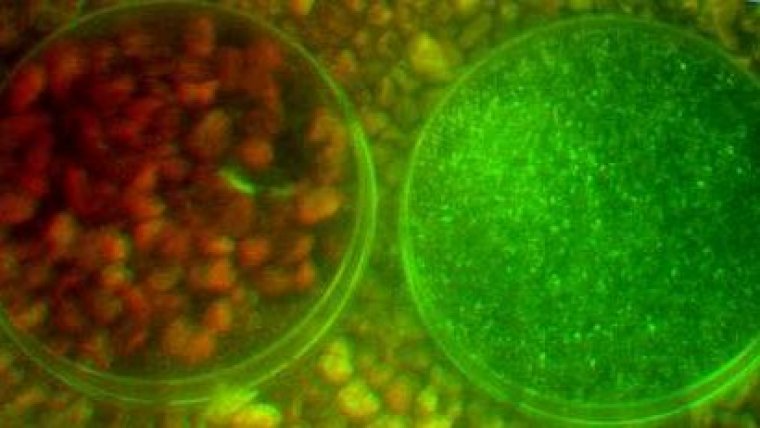| News / Science News |
New color vision pathway unveiled
NIH | MAY 3, 2016
Which colors humans and other animals see depends on the light-sensing cells, or photoreceptors, in the eye. There are 2 types of photoreceptors: rods, which detect dim light and are used for night vision, and cones, which detect different colors and require brightly lit environments.

Bedding soiled with urine (left) and plant seeds (right) shown through filters that simulate mouse rod and cone cells’ light-detection levels. ![]()
Humans have 3 distinct color-sensing cones—for red, green, and blue light. By combining these cells’ signals, the brain can distinguish thousands of different colors. Most other mammals only have 2 types of cone cells, for green and blue/ultraviolet (UV) light.
Unlike humans, mice and other small mammals’ cone cells are segregated in the retina, the light-sensitive tissue at the back of the eye. Because of their locations, the cone cell signals can’t be compared in the same way as they are in people to determine color.
The researchers surveyed retinal ganglion cells, which integrate signals from cone cells and transmit information about color to the brain, by measuring their responses to different colored lights. They discovered a type of ganglion cell that was excited by green light but suppressed by UV light.
The upper part of a mouse’s visual field holds blue/UV cones and the lower part has green cones. The scientists presumed ganglion cells would only respond to colors detected by nearby cones. However, these ganglion cells responded to green light even where green cone cells were absent.
Rod cells haven’t been thought to play a role in color vision, but they do contain a pigment that’s sensitive to green light. Rod cells activate horizontal cells, which inhibit cone cell signaling to retinal ganglion cells. Thus, the ganglion cells can integrate both green light information coming from rod cells and blue/UV light information coming from cone cells in order to send information about color to the brain.
The researchers used camera filters to simulate mouse rod and cone cells’ light-detection levels. They imaged UV-green colored objects that mice commonly encounter and found that urine markings (used for social communication in mice) and plant seeds (a food source) were easier to distinguish.
The human retina has all of the components for this circuit as well. The researchers suggest this might explain why humans perceive the color blue during twilight hours. “In really dim light, our cones don't receive enough photons to work, but they continue to emit a low-level baseline signal to the rest of the retina that is independent of light,” Meister says. “The rods are active, however, and through the horizontal cell they inhibit both the red and green cones. Because this baseline signal from the red and green cones is suppressed, it looks like the blue cones are more active. To the rest of the retina, it seems like everything in the field of vision is blue.”
YOU MAY ALSO LIKE


